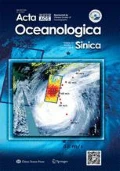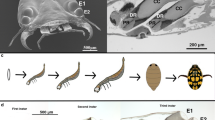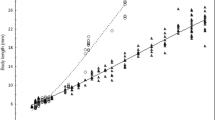Abstract
The analysis of growth bands in the eyestalk has been increasingly used for estimating crustacean ageing and molting. In this study, we developed an effective method to process and observe the eyestalk microstructure of the swimming crab (Portunus trituberculatus). We found that dark pigmentation as a result of boiling has an influence on the observation of the eyestalk microstructure. Choosing an unboiled eyestalk, this study compared the cross section and longitudinal section, and concluded that the cross section is suitable for the observation of growth increments with 6.1% CV (coefficient of variation), and growth bands are suitable for the observation of the longitudinal section with 5.4% CV. The width of growth increments near the edge of the endocuticle is small, and the width of growth increments of the middle part of the endocuticle is large. Relationship of number of growth bands to molting time was fitted to a linear function with the slope not significantly different from 1, indicating that growth bands are formed associated with molting. Periodicity of growth increment formation was calculated as 3.7 d, however was not verified. Our results provide a new improved technique for identification of crustacean molting and growth.
Similar content being viewed by others
References
Belchier M, Edsman L, Sheehy M R J, et al. 1998. Estimating age and growth in long-lived temperate freshwater crayfish using lipofuscin. Freshwater Biology, 39(3): 439–446, doi: https://doi.org/10.1046/J.1365-2427.1998.00292.x
Bubb D H, Lucas M C, Thom T J, et al. 2002. The potential use of PIT telemetry for identifying and tracking crayfish in their natural environment. Hydrobiologia, 483(1–3): 225–230
Chang W Y B. 1982. A statistical method for evaluating the reproducibility of age determination. Canadian Journal of Fisheries and Aquatic Sciences, 39(8): 1208–1210, doi: https://doi.org/10.1139/f82-158
Clore J L. 2014. Investigation of the definitive age of freshwater decapod crustaceans, Orconectes propinquus and Procambarus clarkii, via growth bands in the calcified regions of the eyestalk and gastric mill [dissertation]. Allendale: Grand Valley State University, 29
Dai Aiyun, Feng Zhongqi, Song Yuzhi, et al. 1977. Preliminary investigation on fishery biology of Portunus trituberculatus. Chinese Journal of Zoology (in Chinese), (2): 30–33
Dong Zhiguo. 2012. The study on morphology, biochemistry, molecular phylogeography and genetic diversity of the swimming crab Portunus trituberculatus along China Coast (in Chinese)[dissertation]. Shanghai: Shanghai Ocean University
Feng Yuai. 1984. Shrimp crab shells and each molt. Journal of Fisheries Research (in Chinese), (2): 46–50
Flores L, Ernst B, Parma A M. 2010. Growth pattern of the sea urchin, Loxechinus albus (Molina, 1782) in southern Chile: evaluation of growth models. Marine Biology, 157(5): 967–977, doi: https://doi.org/10.1007/s00227-009-1377-9
Gao Tianlong, Wang Yanfei, Bao Xuening, et al. 2016. Study on the characteristics of molting and growth of Portunus trituberculatus cultured in single individual basket. Journal of Biology (in Chinese), 33(3): 41–46
Gardner C, Jenkinson A, Heijnis H. 2002. Estimating intermolt duration in giant crabs (Pseudocarcinus gigas). In: Paul A J, ed. Crabs in Cold Water Regions: Biology, Management, and Economics, Vol 19. Fairbanks: Alaska Sea Grant College Program, 17–28
Jackson G D, Forsythe J W, Hixon R F, et al. 1997. Age, growth, and maturation of Lolliguncula brevis (Cephalopoda: Loliginidae) in the northwestern Gulf of Mexico with a comparison of length-frequency versus statolith age analysis. Canadian Journal of Fisheries and Aquatic Sciences, 54(12): 2907–2919, doi: https://doi.org/10.1139/f97-192
Jiang Rui, Liu Bilin, Liu Huaxue, et al. 2018. Microstructures of eye-stalks of three common commercial shrimp and crab species in China. Oceanologia et Limnologia Sinica (in Chinese), 49(1): 99–105
Kilada R, Sainte-Marie B, Rochette R. 2012. Direct determination of age in shrimps, crabs, and lobsters. Canadian Journal of Fisheries and Aquatic Sciences, 69(11): 1728–1733, doi: https://doi.org/10.1139/cjfas-2012-0254
Krafft B A, Kvalsund M, Søvik G, et al. 2016. Detection of growth zones in the eyestalk of the Antarctic krill Euphausia superba (Dana, 1852) (euphausiacea). Journal of Crustacean Biology, 36(3): 267–273, doi: https://doi.org/10.1163/1937240X-00002428
Lin Ying, Lin Ruixun. 1993. Crab shell configuration and its existence of each component in the relationship. Journal of Chemistry (in Chinese), (6): 37–40
McPherson R. 2002. Assessment of T bar anchor tags for marking the Blue Swimmer Crab Portunus pelagicus (L.). Fisheries Research, 54(2): 209–216, doi: https://doi.org/10.1016/S0165-7836(00)00303-9
Miyake S. 1983. Japanese Crustacean Decapods and Stomatopods in Color. Vol. II. Brachyura (Crabs) (in Japanese). Osaka: Hoikusha Publishing, 82–83
Oosthuizen A. 2004. A development and management framework for a new Octopus vulgaris fishery in South Africa. Mathematics, 8(2): 815–830
Schöne B R, Fiebig J, Pfeiffer M, et al. 2005. Climate records from a bivalved Methuselah (Arctica islandica, Mollusca; Iceland). Palaeogeography, Palaeoclimatology, Palaeoecology, 228(1–2): 130–148
Secor D H, Hines A H, Place A R. 2002. Japanese hatchery-based stock enhancement: lessons for the Chesapeake Bay blue crab. College Park, Maryland: Maryland Sea Grant Program
Sheridan M, Officer R, O’Connor I, et al. 2015. Investigating the feasibility of using growth increments for age determination of Norway lobster (Nephrops norvegicus) and brown crab (Cancer pagurus). Journal of Crustacean Biology, 35(4): 495–498, doi: https://doi.org/10.1163/1937240X-00002341
Skurdal J, Asbjørn Vøllestad L, Qvenild T. 1985. Comparison of scales and otoliths for age determination of whitefish Coregnous lavaretus. Fisheries Research, 3: 237–243, doi: https://doi.org/10.1016/0165-7836(85)90024-4
Sun Yingmin, Song Zhile, Yan Ruishen, et al. 1984. Preliminary study on the growth of Portunus Trituberculatus. Acta Ecologica Sinica (in Chinese), 4(1): 57–64
Vogt G. 2012. Ageing and longevity in the Decapoda (Crustacea): a review. Zoologischer Anzeiger—A Journal of Comparative Zoology, 251(1): 1–25, doi: https://doi.org/10.1016/j.jcz.2011.05.003
Weingartner D L. 1982. A field-tested internal tag for crayfish (Decapoda, Astacidea). Crustaceana, 43(2): 181–188, doi: https://doi.org/10.1163/156854082X00515
Yang Qiao, Bai Mingyue. 2012. Improvement of piecewise function represented by unit step function and it’s applications. Journal of North China Institute of Water Conservancy and Hydroelectric Power (in Chinese), 33(5): 119–121
Zhao Hongxia. 2006. Study on regulation of the molt of crustacean and the application of molt-accelerating hormone. Guangdong Feed (in Chinese), 15(1): 32–35
Author information
Authors and Affiliations
Corresponding author
Additional information
Foundation item: The National Key R&D Program of China under contract No. 2019YFD0901404; the National Natural Science Foundation of China under contract No. 41876141; the Program for Professor of Special Appointment (Eastern Scholar) at Shanghai Institutions of Higher Learning under contract No. 0810000243; the Shanghai Pujiang Program under contract No. 18PJ1404100; the Shanghai Science and Technology Innovation Action Plan under contract No. 19DZ1207502; Programs Foundation of Ministry of Education of China under contract No. 20133104120001.
Rights and permissions
About this article
Cite this article
Liu, B., Zhang, J., Rui, J. et al. Growth marks in eyestalks of Portunus trituberculatus: A development of technique and evidence of molting. Acta Oceanol. Sin. 40, 84–91 (2021). https://doi.org/10.1007/s13131-021-1774-6
Received:
Accepted:
Published:
Issue Date:
DOI: https://doi.org/10.1007/s13131-021-1774-6




